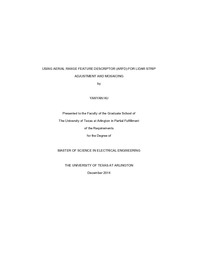
ATTENTION: The works hosted here are being migrated to a new repository that will consolidate resources, improve discoverability, and better show UTA's research impact on the global community. We will update authors as the migration progresses. Please see MavMatrix for more information.
Show simple item record
| dc.contributor.author | Hu, Yanyan | en_US |
| dc.date.accessioned | 2015-07-01T17:50:36Z | |
| dc.date.available | 2015-07-01T17:50:36Z | |
| dc.date.issued | 2014-12 | |
| dc.date.submitted | January 2014 | en_US |
| dc.identifier.other | DISS-12971 | en_US |
| dc.identifier.uri | http://hdl.handle.net/10106/24975 | |
| dc.description.abstract | Light Detection and Ranging (LiDAR) has become the primary surface data extraction mapping technique nowadays. Airborne LiDAR system consists of three major components, which are laser ranging and scanning unit, Global Position System (GPS) and Inertia Measurement Unit (IMU). LiDAR data are collected in a rectangular strip-wise pattern with 10% - 30% overlapping ratio between adjacent strips. When the calibration parameters within the system components are not accurately determined, systematic errors might occur within LiDAR strips. The systematic errors lead to strip discrepancies, which will further affect the quality of end-user products like Digital Elevation Map (DEM) or Digital Surface Map (DSM). In order to reduce or eliminate the discrepancies, various LiDAR strip adjustment methods have been proposed.Aerial Range Feature Descriptor (ARFD) and a corresponding ARFD-based LiDAR strip matching algorithm are developed to solve strip adjustment problem for two LiDAR strips. The algorithm transforms one strip onto the other in such a way that relative discrepancies between the two LiDAR strips are minimized. The transform model is equivalent to the homography matrix relating the two strips and can be determined by taking advantages of feature-based image registration technique like Scale Invariant Feature Transformation (SIFT). However, with the presence of more than two LiDAR strips, the strip matching problem becomes a strip mosaicing problem and a more sophisticated algorithm is required to mosaic multiple LiDAR strips.In this thesis, a LiDAR strips mosaicing algorithm is proposed and the performance is evaluated under various conditions. It takes advantages of the ARFD-based LiDAR strip matching algorithm and extends it to multiple strips. The novelty of the proposed algorithm is that it borrows the concept of bundle adjustment from computer vision community and utilizes the systematic bias model to reduce/eliminate the global strip discrepancies. | en_US |
| dc.description.sponsorship | Devarajan, Venkat | en_US |
| dc.language.iso | en | en_US |
| dc.publisher | Electrical Engineering | en_US |
| dc.title | Using Aerial Range Feature Descriptor (ARFD) For LiDAR Strip Adjustment And Mosaicing | en_US |
| dc.type | M.S. | en_US |
| dc.contributor.committeeChair | Devarajan, Venkat | en_US |
| dc.degree.department | Electrical Engineering | en_US |
| dc.degree.discipline | Electrical Engineering | en_US |
| dc.degree.grantor | University of Texas at Arlington | en_US |
| dc.degree.level | masters | en_US |
| dc.degree.name | M.S. | en_US |
Files in this item
- Name:
- Hu_uta_2502M_12971.pdf
- Size:
- 3.718Mb
- Format:
- PDF
This item appears in the following Collection(s)
Show simple item record


